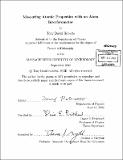Measuring atomic properties with an atom interferometer
Author(s)
Roberts, Tony David, 1972-
DownloadFull printable version (6.783Mb)
Other Contributors
Massachusetts Institute of Technology. Dept. of Physics.
Advisor
David E. Pritchard.
Terms of use
Metadata
Show full item recordAbstract
Two experiments are presented which measure atomic properties using an atom interferometer. The interferometer splits the sodium de Broglie wave into two paths, one of which travels through an interaction region. The paths are recombined, and the interference pattern exhibits a phase shift depending on the strength of the interaction. In the first experiment, the interaction involves a gas. De Broglie waves traveling through the gas experience a phase shift represented by an index of refraction. By measuring the index of refraction at various wavelengths, the predicted phenomenon of glory oscillations in the phase shift has been observed for the first time. The index of refraction has been measured for sodium atoms in gases of argon, krypton, xenon, and nitrogen over a wide range of wavelength. These measurements offer detailed insight into the interatomic potential between sodium atoms and the gases. Theoretical predictions of the interatomic potentials are challenged by these results, which should encourage a renewed effort to better understand these potentials. The second experiment measures atomic polarizability with an atom interferometer. Here, the interaction is with an electric field; the atom experiences a phase shift proportional to its energy inside the field. Previously, this method was used to perform the most accurate (< 1%) measurement of sodium polarizability. The precision was limited, however, by the spread of velocities in the atomic beam-the phase shift is different depending on velocity, and the -interference pattern is washed out. (cont.) This thesis presents a new technique to "rephase" the interference pattern at large applied fields, and demonstrates a measurement that is free of this limitation. In addition, most of the systematic errors that plagued the previous polarizability measurement are eliminated by the new technique, and an order of magnitude improvement in precision now appears quite feasible. The remaining systematic errors can be eliminated by measuring the ratio of polarizabilities between two different atoms, a comparison whose precision is better by another order of magnitude.
Description
Thesis (Ph. D.)--Massachusetts Institute of Technology, Dept. of Physics, 2002. Includes bibliographical references (p. 177-186).
Date issued
2002Department
Massachusetts Institute of Technology. Department of PhysicsPublisher
Massachusetts Institute of Technology
Keywords
Physics.